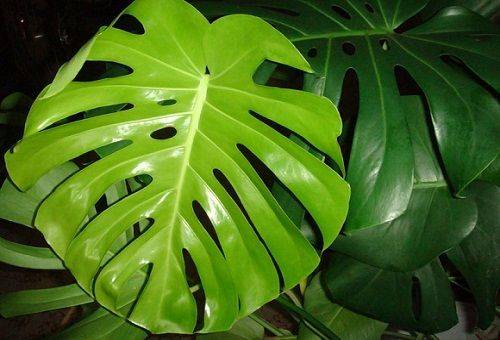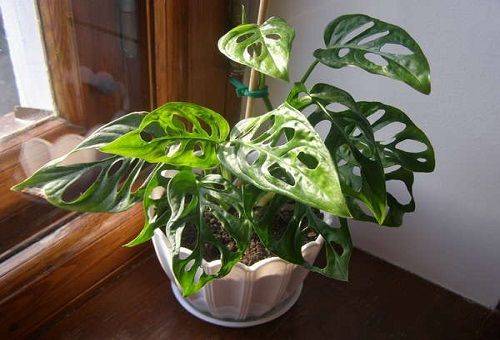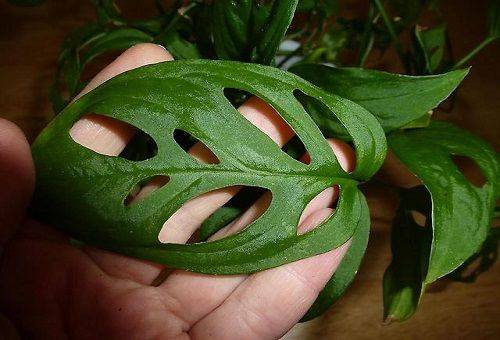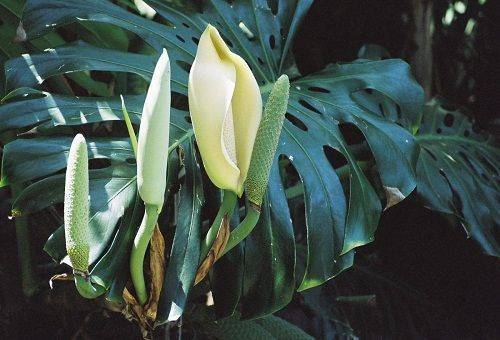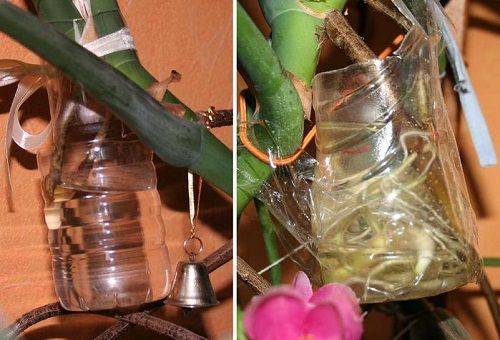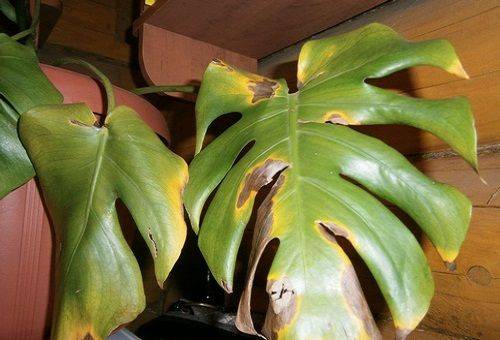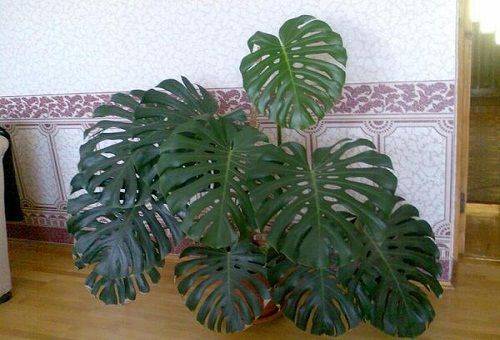How to properly care for the monster at home?
Content:
Monstera is a representative of an extensive family of tropical plants, which is characterized by characteristic cuts on large leaves of a juicy green color. Caring for a monster is so simple that even novice growers can do it. You just need to create a flower for optimal conditions and regularly perform simple manipulations.
The fleshy leaves of the plant contribute to the ionization of the air, so in rooms with a monster it seems to breathe easier. But we must not forget that this variety of vines belongs to the poisonous representatives of the flora. Its juice irritates the mucous membranes and the skin, so all care procedures should be carried out with great care.
Basic Monster Care
Only a healthy monstera looks attractive and provides high-quality air purification. A bright and lush guest from the tropics will delight at home, if you adhere to the following parameters:
- Temperature mode. The flower prefers heat, in the cold it stops growing. In summer, the room should be at least 20ºС, in the coldest winter months - at least 12-13ºС.
- Lighting. Light should be much better if it is bright. In this case, direct sunlight should be avoided, and during a period of increased solar activity, it is advisable to shade the pet. In cases where the monstera suffers from a lack of light, cuts on its leaves begin to form unevenly.
- Humidity. It would be ideal to create an atmosphere of the tropics. At home, this is achieved by spraying the plant with slightly warm water. A nebulizer is needed soft, despite the apparent density of the leaves, large drops can damage them.
Tip: To maintain the health of the monstera, you need to remember the simple dependence of the degree of humidity on the temperature. The warmer the room, the more often and more plentiful the spraying should be. If the room is cold, additional moisture is introduced to a minimum.
- Location and cleaning. The flower is placed on a windowsill or a special hill. You can not bring it closer to heating appliances, dry artificial heat will cause blackening and drying of the leaves. The surface of the plant should be regularly cleaned with a slightly damp cloth, removing dust. Monstera is not very supportive of moving, it is better to initially choose the optimal place for her where she can actively grow.
- The soil. A green pet will feel comfortable in a mixture of turf and peat land, with the addition of sand, humus and soil.
Compliance with basic recommendations will allow the flower to reach a respectable age. First, he will delight with whole leaves of a juicy green hue. Then holes form on them, gradually turning into cuts. Over time, the holes will expand so much that they completely divide the sheet into parts.
Important features of comprehensive care and specific manipulations
Monstera blooms with beautiful white flowers that look like closed lilies. This can be achieved not only in greenhouse, but also at home. To speed up the process, it is worth learning a few secrets from experienced gardeners.
- Watering according to the rules. The plant loves moisture, so from the beginning of spring to late autumn you need to water it abundantly. The lump of earth after this should remain evenly moist. The following approach is carried out only after the soil has dried. If the flower is young and just growing, approaches will be more frequent and solid.For the procedure, a settled room temperature tap water is used.
- Top dressing. At home, the monstera simply can not get all the necessary components from the environment, so feeding can not be avoided. If the leaves of the plant begin to turn yellow, but do not rot or fade, it is time to introduce complex fertilizers. A young flower cannot be brought to this state; it needs to be fed every three weeks. Every year, the topsoil needs to be updated, for this it is recommended to use humus.
- Aerial roots. They do not appear in every instance, but their presence is the norm. It is not necessary to remove formations, it is better to just direct them closer to the soil and, if necessary, provide support.
Even with all the rules of home care, parasites often attack a monster. They need to be eliminated at the first sign, especially if the plant needs to be propagated in the near future. Most often you have to deal with the following pests:
- Thrips. Light spots form on the outer surface of the leaves, and colonies of the parasites themselves can be found on the inside. Insecticides are used to combat the phenomenon.
- Scaffolds. Leaves are covered with brown plaques and begin to fall off gradually. With such signs, the leaves are wiped with a soap solution, and then sprayed with a 0.15% actellic solution.
- Spider mite. A thin web appears on the limp and lifeless leaves. The plant is to be treated with a soapy solution.
- Mealybugs. Usually young leaves and shoots are affected, leading to their drying out and wilting. The fight is also being waged by a soap squad and an actress.
Improper care of the monster at home quickly makes itself felt. Evenly yellowed leaves indicate an excess of moisture, and brown spots indicate its deficiency. Mass decay of healthy leaflets, especially in the lower part of the stem indicates excessive heat. If the leaves do not grow, then this may be due to a lack of sunlight.
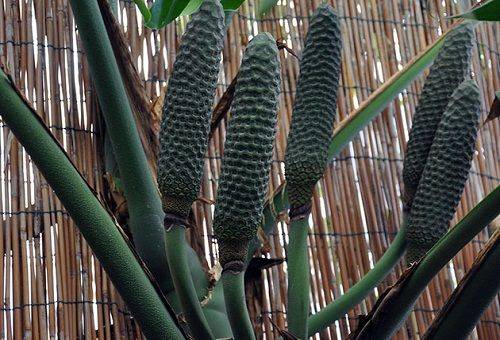
The fruits of a giant monstera
Correct transplantation and reproduction of monstera
In order to qualitatively carry out a transplant and propagation of a plant, it is necessary to work out some skills, but even a beginner will be able to cope with this if he follows all the recommendations of professionals. A plant that is under four years old is subject to transplantation every year, it is enough to transplant an adult individual every 2-3 years. The process itself is quite simple, the main thing is to choose a good pot (larger) and mix the components for the soil correctly. The optimal ratio for transplanting - in terms of humus, sand and peat into three parts of turf. If desired, soil is introduced.
Reproduction of monstera in greenhouse or home conditions can take place in one of three ways:
- Seeds They are placed in the soil, and the pot is put in a warm, bright place. With standard watering, seedlings will be in a month. In a couple of years, the stem will have about 9 leaves.
- Cuttings. Stem or lateral processes are planted in a pot with a layer of drainage and soil from humus mixed with sand. Cover the pot with a glass cap and water it twice a day until the roots appear. Then we transplant the plant into a standard container.
- Air layering. So to propagate a monstera is the easiest. The layering, consisting of a leaf and an aerial root, is simply planted separately, as an independent flower.
At home, a monstera can look fresh and young for a long time. To do this, you need to regularly update the plant. In spring, cut off at least 30 cm of the stem from the top, there must be at least three leaves on it. The cut-off area can be held in water until roots appear and propagated by planting in pots with soil.
We advise you to read the article: nolina care
